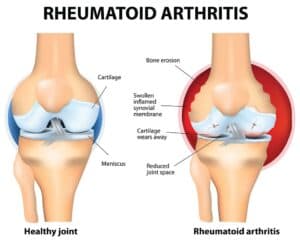Rheumatoid Arthritis is an autoimmune and inflammatory condition where our body’s immune system starts attacking the healthy cells. It causes inflammation in various parts of the body, which leads to pain, swelling, and deformity.
Rheumatoid arthritis mainly attacks the joints and, in most cases, many joints at a time. It affects mainly the hand, wrist and knee joints. In a joint affected with rheumatoid arthritis, the lining of the joint becomes inflamed, gradually leading to damage in that area. Arthritis can cause serious pain, unsteadiness, and deformity.
Rheumatoid arthritis usually develops in four stages:
Rheumatoid arthritis can also affect a number of organs and tissues, such as the lungs, heart, and eyes.
Rheumatoid arthritis typically starts to develop between the ages of 30 and 60, but anyone might develop RA. The development of rheumatoid arthritis symptoms in young adults between ages 16 and 40 is called young-onset rheumatoid arthritis (YORA).
And for those who develop rheumatoid arthritis symptoms after age 60 are called later-onset rheumatoid arthritis (LORA). RA affects women more than men. Around 75% of women are affected by rheumatoid arthritis.
Rheumatoid arthritis can fluctuate in severity, and it’s categorized into periods of flares when symptoms flare up and periods of remission, when symptoms subside.
In the initial stages, rheumatoid arthritis typically affects the smaller joints – particularly those that connect our fingers to our hands, toes with their feet, etc.
As the disease grows, it starts affecting different parts of the body. Some people may later experience symptoms in the knees, ankles and elbows. Others might have symptoms in their shoulders and hips too.
Rheumatoid arthritis symptoms include:
Some people show signs of rheumatoid arthritis in body parts that don’t involve any joints. Such part includes skin, kidneys, eyes, blood vessels, salivary glands, lungs, heart, bone marrow, nerve tissue etc.
Rheumatoid arthritis is an autoimmune disorder where the body’s immune system attacks its own healthy cells. It is currently unknown what causes this, but researchers have identified many factors which can increase the risk of developing rheumatoid arthritis.

Some of them are:
The following methods are commonly used for a rheumatoid arthritis diagnosis.
The doctor will examine our joints and look for any signs of swelling or redness. They may also test muscle strength and reflexes.
Rheumatoid arthritis leads to an increase in the levels of erythrocyte sedimentation rate (ESR) or C-reactive protein (CRP). If the blood test shows positive for these elevations, then it can be diagnosed as rheumatoid arthritis.
The doctor may want to order an X-ray to see the development of rheumatoid arthritis in our joints. MRI and ultrasound scans are also available and can help the doctor measure how severe the disease is in our system.
RA treatment aims to reduce inflammation and pain and help do the things that matter in daily lives. Some common treatments for rheumatoid arthritis include:
The doctor will prescribe the type of medications for rheumatoid arthritis that is most appropriate for our symptoms and the duration of the disease.
These drugs reduce pain and inflammation. Common over-the-counter pain relief drugs are ibuprofen and naproxen sodium.
Some common side effects of NSAIDs are heart problems, damage to the kidney and irritation of the stomach.
Steroid medications can provide relief to people with joint pain in a short amount of time. However, they come with side effects such as thinning bones, diabetes and weight gain.
Doctors often prescribe these types of drugs for short term relief, but they may not be the best long-term solution.
DMARDs can help hamper in the development of rheumatoid and protect the joints from getting damaged permanently.

Therapy for rheumatoid arthritis has drastically improved in the past 30 years. Our physical or occupational therapist will prescribe exercises that will assist in improving the flexibility of the joints and also suggest new ways to do tasks that don’t put much strain on our joints.
The therapist may also recommend certain assistive devices such as cane wraps and splints to reduce joint pain.
In some cases, when medication and therapy fail, surgery is needed. It can help restore our ability to use our joints, relieve some of the pain and improve our movements. Surgeries include synovectomy, joint fusion, tendon repair etc.
Although there is no guarantee we will avoid developing rheumatoid arthritis due to factors such as age, sex and family history, there are still a few significant things that may help decrease the risk of developing RA:
Rheumatoid arthritis is a common form of autoimmune arthritis that can cause inflammation in various parts of the body, which leads to pain, swelling, and deformity.
RA affects more women (around 75%) than men. There are currently no definite known causes for the development of rheumatoid arthritis, and also there is no permanent cure for this condition. Treatment includes medication, therapy and surgery.
The multidisciplinary care team at the CK Birla Hospital provides expert care regarding rheumatoid arthritis. To learn more about this issue, visit the CK Birla Hospital or book an appointment with Dr. Rajiv Ranjan Kumar.